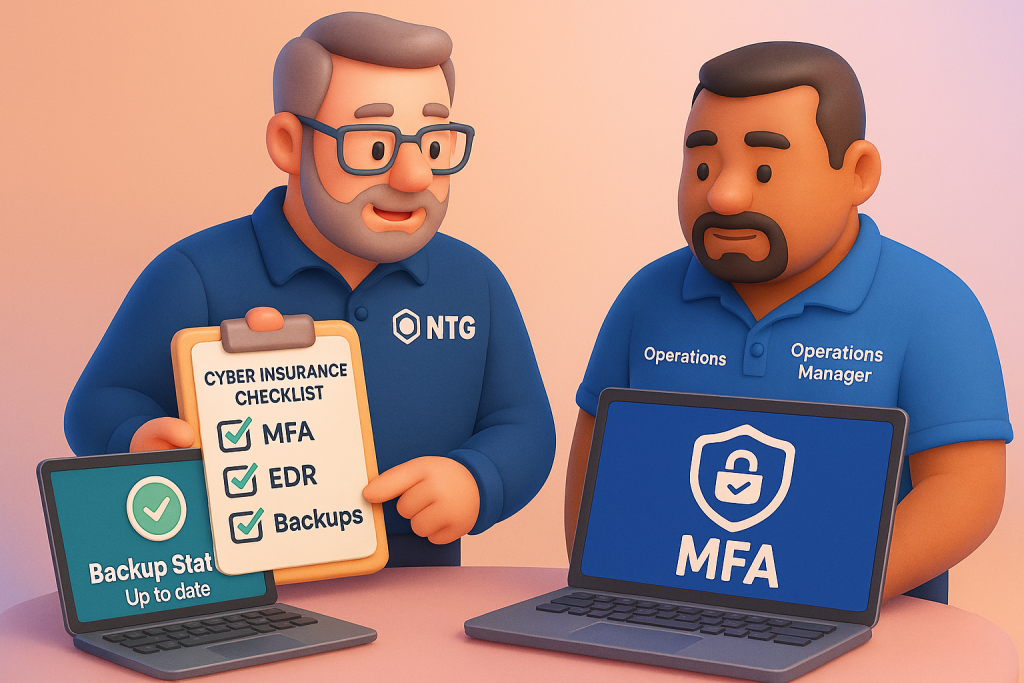 Cyber Insurance Requirements: A Plain‑Spoken Guide From the Trenches in San Diego
Cyber Insurance Requirements: A Plain‑Spoken Guide From the Trenches in San Diego
If you turned on your business computers this morning and saw a ransomware lock screen, could you keep your company moving—today? Could you get systems back online, notify the right people, and prove to an insurer that you met the cyber insurance requirements your policy expects? Research from Sage found that 48% of small and mid‑sized businesses experienced a cybersecurity incident in the past year.
I run Noble Technology Group (NTG) in La Mesa. We blend managed IT services, responsive IT support, pragmatic IT consulting, and practical compliance services so you can run jobs, serve patients, and sleep at night.
e by phone for remote support or to come onsite as needed.” — Susan Martinez, California Marine Cleaning
Why Cyber Insurance Isn’t a Silver Bullet—And Why You Still Need It
Cyber insurance doesn’t stop criminals. It funds the legal, forensics, recovery, notification, and PR teams you need when minutes matter. It’s a lifeline so one incident doesn’t knock out your cash flow or reputation.
The Short Version: What Most Cyber Insurance Requirements Look Like
- MFA everywhere (email, remote access, admin, finance apps, backups).
- EDR/MDR on servers and endpoints.
- Patching with proof you close high‑risk issues on schedule.
- Backups that are encrypted, versioned, tested, and preferably immutable/offline.
- Security awareness training + phishing simulations with tracked participation.
- Incident response plan with roles, timelines, and call tree.
“They provide amazing customer service! Highly recommended.” — Matt Jones, Google Review
What Your Policy Actually Covers (And What It Doesn’t)
Policies usually include first‑party (your recovery) and third‑party (liability) coverages, plus breach counsel, forensics, notifications, and business interruption. Mismatched or missing controls can reduce or deny a claim.
Underwriters look at revenue, industry, data sensitivity, geography, loss history, and your control posture. Regulated environments (HIPAA, CMMC/NIST) raise scrutiny—but the same controls that satisfy compliance also please insurers.
Your Evidence Binder: What To Have Ready Before You Apply
- MFA: policy exports/screenshots.
- EDR: deployment report with device coverage.
- Patching: monthly vulnerability remediation summary.
- Backups: topology, immutability, last restore test results.
- Training: completion rosters + phishing metrics.
- IR Plan: version date, last tabletop notes.
“We prove restores every month, after hours, so your floor keeps moving.”
The Starter Conversation I Have With Every Owner
- Containment within minutes — EDR/MDR + alerting + response
- MFA as the last lock if a password leaks
- Restore clean copies fast — validated
- Call counsel + carrier hotline early
- Show a disciplined, repeatable program
A Quick Reality Check on Ransomware
Ransomware often starts with phishing, stolen credentials, or missing patches. EDR catches movement, backups remove the leverage, and training lowers the click rate.
What Clients Say About Working With Us
“NTG has always been reliable and flexible… the whole package.” — Dr. Candy Lewis, Harmony Animal Hospital
“Peter and Roody… always available to answer questions… in‑person visits… they always get us taken care of!” — Sarah Gonzalez, Google Review
“Lisa is outstanding. They do a great job.” — Jason R., Google Review
Learn more:
The 10‑Point Cyber Insurance Requirements Checklist
- MFA enforced for M365, VPN, admin, finance, and backups
- EDR/MDR on 100% of in‑scope assets
- Vulnerability management with 30‑day SLA
- Encrypted, offsite/immutable backups + recent restore test
- Email security + user report button
- Security awareness training + phishing simulations
- IR plan with legal, carrier, MSP contacts
- Least privilege + privileged access management
- Vendor risk management list
- After‑hours change windows + rollback plans
Underwriting Questions You’ll Probably See
Expect proof for MFA, EDR, backups, training, and IR testing. We prepare that “evidence binder” so renewals and claims go faster.
The First 24 Hours: What We Do If You Get Hit
- Contain devices; disable suspect accounts; block C2
- Call counsel and carrier hotline early
- Forensics: preserve logs and artifacts
- Restore from clean backups; validate
- Communicate with staff/customers as needed
- Harden post‑incident (passwords, MFA resets, segmentation, patches)


